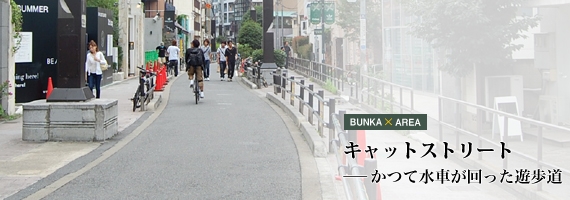
Gathering the shop of the fashion system and design system, Cat Street, which is one of the advanced area among the Shibuya (Shibuya River promenade). Walking through the neighborhood, such as old houses and renovation (renovation), you will notice that there are many shops and restaurants to divert as a store. These phenomena, might be said to symbolize the charm of Cat Street old and new cultures melt together. With Disclose the history of this area, I tried to follow the culture that has been formed therein.

Current Cat Street (Shibuya River promenade)
Cat Street that connects the Shibuya and Omotesando in parallel with the Meiji-dori. Eaves shops that sensitively reflect the trend in the pedestrian street of the gentle curve, but this area is from the state-of-the-art appearance has hidden a deep history of inconceivably. This walking dictionary existence of regional, Sato Ginkasane who serve the Harajuku 穏田 (Onden) shopping Board Chairman.
1933 Sato of the year born, born and raised in this neighborhood, we have been witnessing over the dramatic changes in the ambient in nearly 70 years. In the vicinity of the "current of Shibuya River promenade, perhaps as had been inhabited from the Jomon period. Although not very well known, because the ruins from here and there is excavated, has been designated as a cultural property protected areas "
From "Komota" to "穏田"

Once referred to as the 穏田 river, Shibuya River, which had turned the water wheel
Photo courtesy 穏田 town council

Stand out sales of fruit and vegetable shop in the mall

Tidbit also appearance of the cat get the food
That year, the Shibuya River, which had progressed already contaminated with domestic waste water from around the house are culverts, it became a road of asphalt pavement. Yet at the time, but this neighborhood is there were many children in the residential area, so that there is no park in the vicinity was a headache. Then, when Let's make a children's playground, slide and swing, such as the Sand it has been installed in a place where there is a current of Cat Street. "From Shibuya to Omotesando, because I had followed all the way, it was a pretty elongated park. Even now you are still a little play equipment in Shibuya side. It is the time of the remnant."
To eventually park, stray cats without began gathering from nowhere. Since the peripheral of the residents give the bait, the number continues to grow, we will gradually become a park full of cat ──. "" There are several theories on the origin of the name of Cat Street ", but it is the dominant theory is that because I have so many cats together". When the road is in place, passers-by also started increasing, gradually as was increasingly crowded. "After watching the sport in the Shrine, now pass through a person toward the Shibuya Station direction to walk down this street. Especially crowds of the day of the Waseda-Keio game guess it was amazing."
Before long, to "fashion town"

Pink Dragon
And it became a major turning point is, is that the brands began to opening the gang shop since I was a bubble in Omotesando. Although shops in Cat Street began to grow at its impact, Omotesando and the big difference was that gathered many strong shop of street sense. Gathering is unique shops with a focus on old clothes system and indie from the mid-1990s, it became the epicenter of the epidemic is called the "Harajuku" is symbolizes it. Further in parallel, 1998 "Patagonia", such as the 2000 "United Arrows," "hhstyle.com", large shop also open the fashion system and the design system. As an area to focus on young people of the personality and sensibility, we now increasingly strengthen the transmission power of the trend as well.

Playground equipment that remains in the Shibuya River promenade is tell the vestiges of the days of yore
 |
Sato Ginkasane's 1933 birth. Jingumae (up residence indication amendment of 1965 has been called "穏田") was born and raised. After the retirement of the financial system of the company, it opened a "Harajuku Wako housing" of the real estate brokerage in Jingumae 6-chome. Currently, he serves as the Harajuku 穏田 shop chairman and Shibuya shopping Federation Vice Chairman. |
[KEYPERSON] Shujiro Kusumoto (Cafe and Company, Inc. President and CEO)
"Cat Street" around culture facility